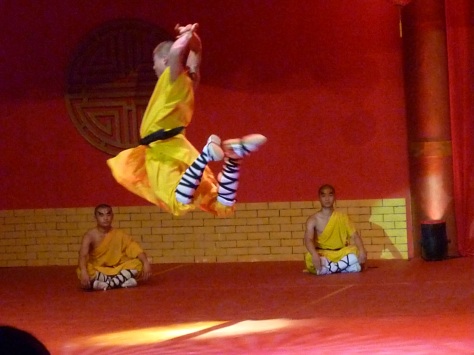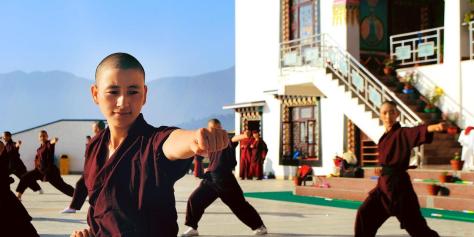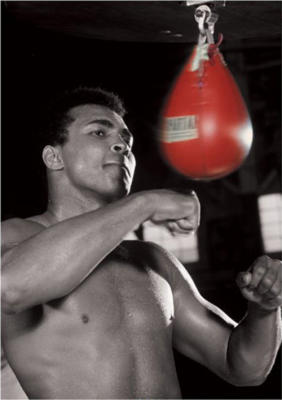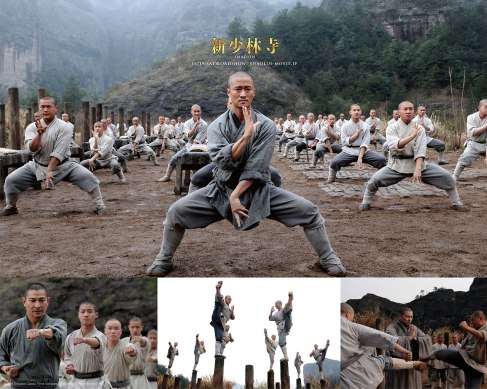«No te pongas límites, ponte objetivos»

Muchas veces nos preocupamos por nuestros límites, o creemos que están mucho más cerca de lo que realmente están.
Sí, hay límites, claro que los hay: Nuestra capacidad aeróbica, nuestra capacidad muscular, nuestras articulaciones, nuestra salud, nuestro conocimiento, todos son límites, pero los límites ya están ahí, no hace falta vivir en ellos. En vez de eso, ponte objetivos, cortos, medianos, pero reales.
Una vez que hayas puesto un objetivo concreto, así sea «lograr un minuto y medio de MaBu» ó «patear más alto» ó «aprender una forma corta» ó «lograr entrenar una hora por día», sea cual sea el objetivo, ahí es donde comienzas a establecer CÓMO vas a llegar a eso que quieres.
¿Quieres lograr el minuto y medio de MaBu?
Bien, alterna días de entrenamiento de MaBu al máximo con descansos y con entrenamientos intermitentes de posturas, avanza tu tiempo de MaBu de a diez segundos y cuando te estanques (limite físico), descansa y deja que lo que ya has fortalecido se «asiente» en tu cuerpo y recuperes tu capacidad. Ahí, vuelve a intentarlo.
¿Quieres lograr patear más alto?
Añade más estiramientos antes y después de entrenar e inclusive has sesiones diarias de estiramiento suave, para que músculos y articulaciones se acostumbren a permanecer estirados.
¿Quieres aprender una forma corta?
Sencillo, mira muchos videos de la forma, pero selecciona solo uno y copia de a UN movimiento, hasta que te salga igual o muy parecido a lo que estás viendo. Luego haz lo mismo con las siguientes dos posturas. Luego encadena todo eso, luego descansa y vuelve a intentar desde el principio, no aprendas más de tres o cuatro movimientos/posturas por semana y al cabo de un mes o más (dependiendo de la forma) ya sabrás «caminar la forma» o sea, la tendrás terminada y luego necesitarás otros meses más para pulir detalles y hacer correcciones. Dependiendo de la forma esto puede demorar más o menos. Si eres nuevo, empieza con algo básico.
¿Quieres entrenar una hora por día?
Ármate un calendario de tu semana, fíjate que espacios tienes libre y ponte alarmas, recordatorios y todo lo que puedas para motivarte a entrenar. ¿Juegas mucho videojuegos, ves mucha tele o pasas mucho tiempo con tu celular? Bueno, recicla ese tiempo, aprovéchalo para entrenar aunque sea media hora, luego conviértela en 45 minutos y luego en una hora. Oblígate al menos a hacerlo una semana y verás los resultados, ponte como recompensa el «jugaré el fin de semana» y piensa que le estás dando SALUD y FUERZA a tu cuerpo. Eso es mucho más valioso.
Sea cual sea el objetivo que elijas, pondrá a prueba tus límites (tiempo, elongación, fuerza, resistencia, paciencia, etc) y ahí es donde tu debes hacer tu esfuerzo, tener perseverancia, voluntad, dedicación y superarlos. No hay secretos, son solo tú y tu capacidad de pasar los obstáculos.
… y recuerda: FALLAR es parte del camino.
Fallar no es algo que «no debería» suceder, todo lo contrario, el fallo es lo que te va marcando la dirección, te enseña y te lleva hasta el éxito. Abraza los fracasos, aprende de ellos y sigue adelante.
¡Vamos! ¡Todos juntos! JIA YOU!
¡A entrenar!
– EKF –
http://www.entrenandokungfu.com
IG: @entrenandokungfu
FB: http://www.facebook.com/EntrenandoKungFu
«Don’t put limits, set objectives»
Many times we worry about our limits or we think that are much closer that they really are.
Yes, there are limits, of course. Our aerobic condition, our muscles strenght, our joints, our health, our knowledge, all of these are limits, but limits are already there, you don’t need to live in them. Instead, just set objectives, short and/or medium term, but realistic.
Once you’ve set an objective, either «holding a minute and a half on MaBu» or «kicking higher» or «learn a short form/taolu» or «reach one hour per day of training», it doesn’t matter which, but there’s where you are going to establish HOW you are going to reach those objectives.
Wanna reach a minute and a half on MaBu?
Ok, altern days of MaBu training at your maximum, with rests and trainings of intermittency with stances, increase your MaBu time 10 seconds per day and when if you get stuck (physical limit) relax and leave what you’ve already trained to «settle down» and recover your capacity. Once there, try again.
Wanna kick higher?
Add more stretching before and after training, even do daily sessions of SOFT stretching, so muscles and joints can get used to be always stretched.
Wanna learn a short form/taolu?
Easy, watch as many videos as possible of the form, but choose just one and copy ONE movement, until you can make it similar to what you are watching there. Then, do the same with the next stance/movement or with two of them. Connect those two three movements from the scratch and take a rest. Try again from the beginning, but nore more than three or four movements/stances per week. And you’ll see after a month or a little bit more (depending on the form) you’ll know how to «walk the form» meaning that you’ll be able to do it completely and then you’ll need one ore two more months to correct details. Depeding on the form it can take more or less. If you are new, always start with a very basic one.
Want to train one hour per day?
Make a calendar for your week, check with times you have available, and set alarms, reminders and whatever you can to keep you up, motivated and aware of your training times. Playing too much videogames or watching too much TV, or just spending too much time with your mobile? Ok, recycle that time, use for training, even if it’s just half an hour, then make it 45 minutes and then an hour. Push yourself, discipline yourself to do it at least for a week and you’ll see the results. Put you as reward «If I do all this training, I’ll play the entire weekend» and think that you will give health and strenght to your body. That’s much more valuable.
Whatever your objective is, it will challenge your limits (time, stretching, strenght, stamina, patience, etc) and there’s where you need to do your effort, perseverance, will, dedication and you’ll fulfill your objectives. There are no secrets, it’s just you and your capacity to overcome to obstacles.
… And remember: FAILING is part of the way
Failing isn’t something that «shouldn’t happen», all the opposite, failure is what will guide your way, will teach you and will finally reach you to success. Embrace failure, learn from it and keep moving forward.
Come on! All together! JIA YOU!
Let’s train!
– EKF –
http://www.entrenandokungfu.com
IG: @entrenandokungfu
FB: http://www.facebook.com/EntrenandoKungFu

















